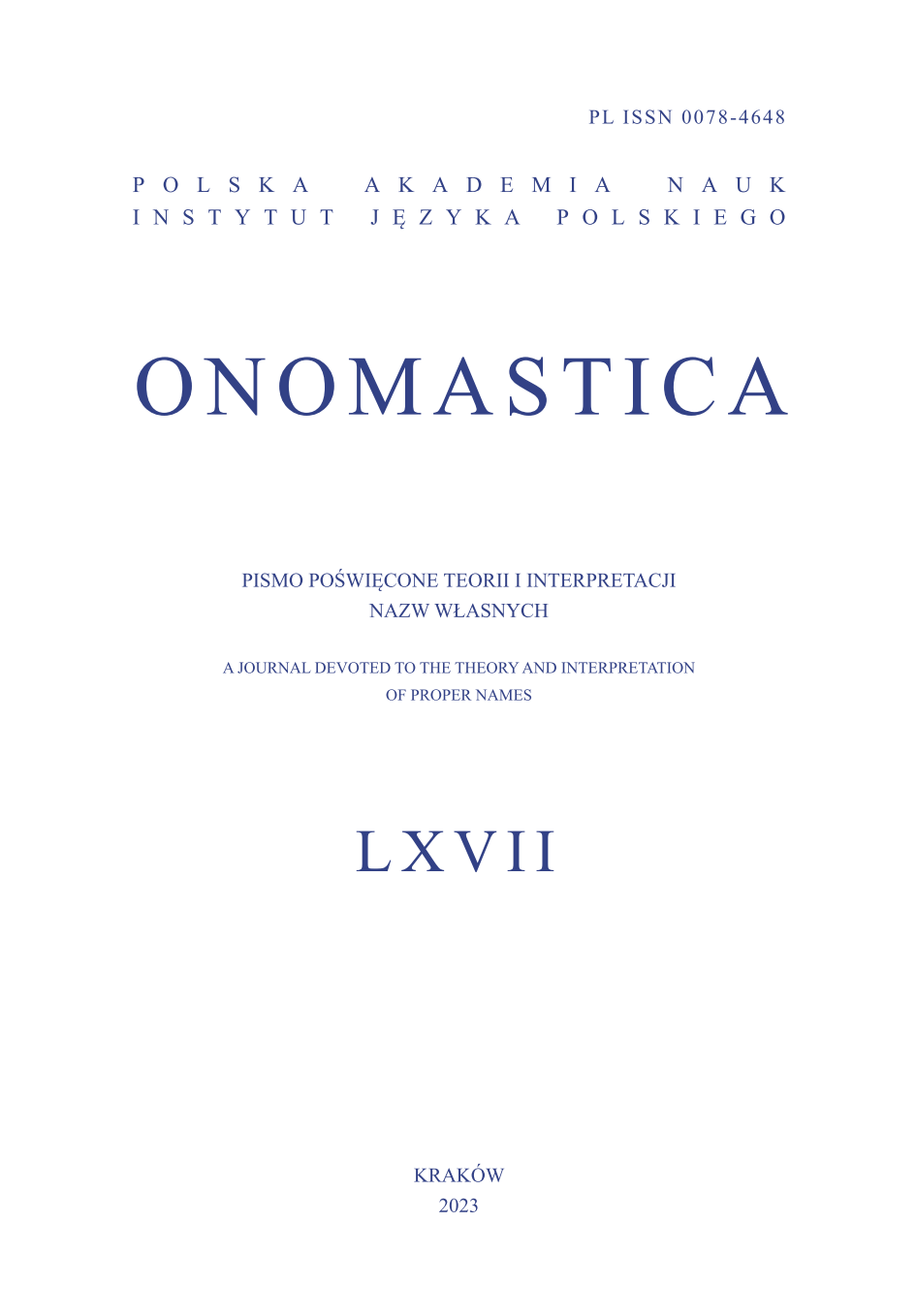Abstract
The Russian–Ukrainian war entered every Ukrainian home and this is reflected in the daily military discourse. Many new military lexemes, including numerous chrematonyms, have appeared in the speech of every Ukrainian. One of the most popular words of the Ukrainian military discourse in 2022 emerged from this class of proper names — the chrematonyms Javelin and Bayraktar, the semantics, pragmatics and functional load of which are analyzed in this study. The relevance of this work is determined by the fact that the phenomenon of chrematonymy is understudied and consists in a new anthropocentric approach to the study of the chrematonymy problem. The purpose of the article is to investigate the functioning of the specified proper names of weapons, to reveal their culturally informative cumulativeness, onymic potential and axiological possibilities in neonomination. It has been proven that the chrematonyms Javelin and Bayraktar turned from neologisms to commonly used words in a short time; they also occupied an important place in the system of onymic area, which is evidenced by their common knowledge, frequency of use, functioning in various styles of speech, Internet memes, and pop culture. The onomasiological approach made it possible to find out the productivity of the analyzed chrematonyms in the creation of new onyms, the relationship between onymic units in the process of their formation, as well as the socio-cultural determination of neonomination and appellativeization of proper names (de-onymization). It was established that the analyzed military chrematonyms are a source for the creation of new onyms (in particular, anthroponyms) as a result of a positive connotation caused by extralingual socio-cultural factors. A linguistic-cultural approach to chrematonyms opens up the perspective of studying the names of weapons as a cultural code, because weapons are one of the oldest artifacts created by man.
References
Абрамов, Р. (2013). Міжонімна омонімія (омонімія власних назв в сучасній українській мові) [Interonymic homonymy (homonymy of proper names) in the modern Ukrainian language]. Записки з ономастики, 16, 18–23.
Вербич, С. (2014). Трансформація українського онімного простору: внутрішньо- та позамовні чинники [Transformation of Ukrainian onymic space: intra- and extralingual factors]. Мовознавство, 2, 15–23. http://dspace.nbuv.gov.ua/handle/123456789/183873
Від «Євшана» до «Байрактара»: Переднє слово [From Yevshan to Bayraktar: Foreword]. (2022). Горбачуківські студії, 7, 4–5.
Карпенко, О. (2008). Хрематонімічний фрейм та фантазії ономастів навколо нього [Chrematonymic frame and the fantasies of onomasts around it]. Studia Slovakistica, 8, 169–176.
Кирилюк, О. (2019). Мовна природа мему [Linguistic nature of a meme]. Наукові записки НаУКМА. Мовознавство, 2, 30–35. https://doi.org/10.18523/2616-8502.2019.2.30-35
Ковтюх, С. (2011). Вплив переносних значення та вживання на морфологічну парадигматику іменників [Influence of figurative meanings and usage on the morphological paradigmatics of nouns]. Наукові записки. Серія: Філологічні науки, 96(2), 48–54. http://dspace.cuspu.edu.ua/jspui/handle/123456789/2142
Космеда, Т. (2011). Мовна гра у системі лінгвістичних термінів [Language game in the system of linguistic terms]. Культура слова, 74, 137–141. http://dspace.nbuv.gov.ua/handle/123456789/37157
Космеда, Т. (2022). Лінгвокреативна ономастика: Медійний образ Володимира Путіна в українському та російському дискурсі [Linguo-creative onomastics: The media image of Vladimir Putin in Ukrainian and Russian discourse]. Onomastica, 66, 219–231. https://doi.org/10.17651/ONOMAST.66.15
Неклесова, В. (2017). Меми як частина онімного простору [Memes as a part of the onymic space]. Записки з ономастики, 20, 210–222. https://doi.org/10.18524/2410-3373.2017.20.133817
Ткаченко, Г. (2017). Хрематоніми ХХІ ст.: власні назви ювелірних прикрас [Chrematonyms of the 21st century: proper names of jewelry]. Записки з ономастики, 20, 255–261. https://doi.org/10.18524/2410-3373.2017.20.133864
Ткаченко, Г. (2018). Глосарій основних ономастичних та когнітивних термінів [Glossary of the major onomastic and cognitive terms]. Записки з ономастики, 21, 208–214. https://doi.org/10.18524/2410-3373.2018.21.155194
Шумицька, Г., Підкуймуха, Л., Кісс, Н . (2022, 14 листопада). Мова як «байрактар», мова як код: до ювілею соціолінгвістки Лариси Масенко [Language as a «bairaktar», language as a code: to the anniversary of the sociolinguist Larisa Masenko]. Радіо Свобода. https://www.radiosvoboda.org/a/larysa-masenko-ukrayinska-mova/32126052.html
Abramov, R. (2013). Mìžonìmna omonìmìâ (omonìmìâ vlasnih nazv v sučasnìj ukraïnsʹkìj movì) [Interonymic homonymy (homonymy of proper names) in the modern Ukrainian language]. Zapiski z onomastiki, 16, 18–23.
Karpenko, O. (2008). Hrematonìmìčnij frejm ta fantazìï onomastìv navkolo nʹogo [Chrematonymic frame and the fantasies of onomasticians around it]. Studia slovakistica, 8, 169–176.
Kirilûk, O. (2019). Movna priroda memu [Linguistic nature of a meme]. Naukovì zapiski NaUKMA. Movoznavstvo, 2, 30–35. https://doi.org/10.18523/2616-8502.2019.2.30-35
Kosmeda, T. (2011). Movna gra u sistemì lìngvìstičnih termìnìv [Language game in the system of linguistic terms]. Kulʹtura slova, 74, 137–141. http://dspace.nbuv.gov.ua/handle/123456789/37157
Kosmeda, T. (2022). Lìngvokreativna onomastika: medìjnij obraz Volodimira Putìna v ukraïnsʹkomu ta rosìjsʹkomu diskursì [Linguo-creative onomastics: The media image of Vladimir Putin in Ukrainian and Russian discourse]. Onomastica, 66, 219–231. https://doi.org/10.17651/ONOMAST.66.15
Kovtûh, S. (2011). Vpliv perenosnih značennâ ta vživannâ na morfologìčnu paradigmatiku ìmennikìv [Influence of figurative meanings and usage on the morphological paradigmatics of nouns]. Naukovì zapiski: Fìlologìčnì nauki (movoznavstvo), 96(2), 48–54. http://dspace.cuspu.edu.ua/jspui/handle/123456789/2142
Neklesova, V. (2017). Memi âk častina onìmnogo prostoru [Memes as a part of the onymic space]. Zapiski z onomastiki, 20, 210–222. https://doi.org/10.18524/2410-3373.2017.20.133817
Šumicʹka, G., Pìdkujmuha, L., Kìss, N . (2022). Mova âk «bajraktar», mova âk kod: do ûvìleû socìolìngvìstki Larisi Masenko [Language as a «bairaktar», language as a code: to the anniversary of the sociolinguist Larisa Masenko]. Radio Svoboda. https://www.radiosvoboda.org/a/larysa-masenko-ukrayinska-mova/32126052.html
Tkačenko, G. (2017). Hrematonìmi ХХІ st.: vlasnì nazvi ûvelìrnih prikras [Chrematonyms of the 21st century: proper names of jewelry]. Zapiski z onomastiki, 20, 255–261. https://doi.org/10.18524/2410-3373.2017.20.133864
Tkačenko, G. (2018). Glosarìj osnovnih onomastičnih ta kognìtivnih termìnìv [Glossary of the major onomastic and cognitive terms]. Zapiski z onomastiki, 21, 208–214. https://doi.org/10.18524/2410-3373.2018.21.155194
Verbič, S. (2014). Transformacìâ ukraïnsʹkogo onìmnogo prostoru: vnutrìšnʹo- ta pozamovnì činniki [Transformation of Ukrainian onymic space: intra- and extralingual factors]. Movoznavstvo, 2, 15–23. http://dspace.nbuv.gov.ua/handle/123456789/183873
Vìd «Êvšana» do «Bajraktara»: Perednê slovo [From Yevshan to Bayraktar: Foreword]. (2022). Gorbačukìvsʹkì studìï, 7, 4–5.


